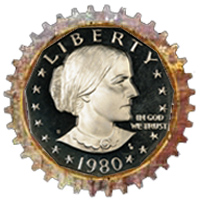Steampunk often features historical figures: the poets, explorers, and scientists of the Victorian period. But few books reference one of the most important political movements of the time: the women’s suffrage struggle. That’s a shame, since the movement had its share of charismatic, unusual characters who rarely surface in speculative fiction.
The suffrage movement got launched in July, 1848 in Seneca Falls, New York (I always thought the two-day convention would make one of the best Call of Cthulhu campaign backdrops ever). Organized by Elizabeth Cady Stanton and Susan B. Anthony, the convention also featured ex-slave Frederick Douglass. One of the most controversial items of the convention was its Declaration of Sentiments (modeled on the Declaration of Independence and written by Stanton) and the inclusion of a resolution concerning women’s right to vote. Many of the convention attendees wanted it struck out, but Douglass and others argued for its inclusion.
Anthony and Stanton continued as major leaders of the women’s suffrage movement throughout their lifetimes, and helped form the National Woman Suffrage Association in 1869. A year later the rival American Women Suffrage Association was formed by Lucy Stone, Elizabeth Blackwell (the first woman to graduate from medical school in the United States) and Julia Ward Howe. The two factions often quarreled bitterly, and didn’t reunite until 1890, thirty years before women finally got the vote in America.
Anthony (you may remember her appearance on a dollar coin) never married, saying that the cause needed women who were willing to eschew love and marriage in order to devote themselves to it. She was arrested in 1872 at the age of 52, for voting in the Presidential election.
Stone is herself another intriguing figure, an accomplished orator sometimes called “The Morning Star,” who (scandalously at the time) decided to keep her own name after marriage to Henry Blackwell, a decision which aided the falling out with Susan B. Anthony, who disagreed with the decision.
Imagine a steampunk suffrage novel, where the two organizations send clockwork spies and assassins in order to combat their rivals. It’s an era rich in possibility, and full of other dynamic characters, like Victoria Woodhull, the first woman to run for President (on a ticket with Douglass), who was also a Spiritualist, a Free Love advocate, and a stockbroker under the guidance (and financing) of Horace Greely. Or Amelia Bloomer who, while she did not create the garment that would be named after her, was one of the first to wear the shocking garment, which revealed that women had actual legs.
Let’s not overlook Sojourner Truth, who encapsulated the struggle that would go on for decades between the abolitionist movement and the suffrage movement and the many members they shared, when she asked:
“That man over there says that women need to be helped into carriages, and lifted over ditches, and to have the best place everywhere. Nobody ever helps me into carriages, or over mud-puddles, or gives me any best place! And ain’t I a woman? Look at me! Look at my arm! I have ploughed and planted, and gathered into barns, and no man could head me! And ain’t I a woman? I could work as much and eat as much as a man – when I could get it – and bear the lash as well! And ain’t I a woman? I have borne thirteen children, and seen most all sold off to slavery, and when I cried out with my mother’s grief, none but Jesus heard me! And ain’t I a woman?”
The suffrage movement was slower to take off in Great Britain, but here as well it featured characters worthy of the occasional inclusion in a novel, the Pankhursts. Emmeline Pankhurst, founder of the Women’s Social and Political Union, and her daughters Amelia and Sylvia also marched and protested for women’s rights while facing a scene equally prone to schism and rivalry. Like many of their American counterparts, the Pankhursts weren’t afraid to be arrested and one of Emmeline Pankhurst’s more quoted remarks is, “The argument of the broken pane is the most valuable argument in modern politics.”
I’ve used some of these figures in my own fiction: Lucy Stone in a short story and Victoria Woodhull in not just a short story but in a proposed alternate history novel where she’s a paranormal detective. I like drawing on their stories in part because I’m haunted by a remark my sister-in-law made several years ago when we were talking about role-playing campaigns. “I want games where there are a range of roles for me,” she said. She wanted something other than maiden or vamp. Steampunk does provide plenty outside the norm, but I’d like to see women as political figures added as long as we’re stirring up the mix.
Certainly such figures existed in real life, with a major one coming in the form of another Victoria, the queen who was the longest reigning female monarch in history and who described the suffrage movement as “This mad, wicked folly of Women’s Rights with all its attendant horrors, on which my poor feeble sex is bent, forgetting every sense of womanly feelings and propriety.” (That’s the same queen who gets turned into a nympho newt-hybrid in Paul Di Filippo’s The Steampunk Trilogy and a lizard in Lavie Tidhar’s The Bookman, the poor woman.)
Certainly I am as charmed as the next feminist when Irene Adler flits through a novel’s page dressed in a clockwork corset. But I’d like to see more of the real life women of the Victorian period drawn on, just as some of the wonderful male figures have been pulled into works, such as Walt Whitman (also in Di Filippo), Sir Richard Burton, Oscar Wilde, Karl Marx, and so forth in a list that seems so much longer than its feminine equivalent that it’s a bit of a shame.
Cat Rambo lives and writes in the Pacific Northwest. You can find links to her fiction at www.kittywumpus.net.










